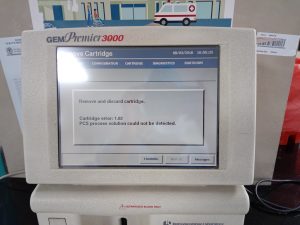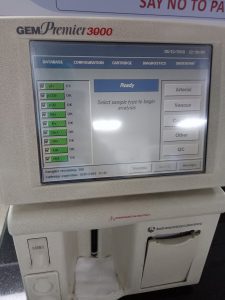ABG machine cartridge Critical Care GEM® Premier 3000 PAK
ABG machine cartridge used for Investigation like Arterial Blood, Venous blood, CSF, Capillary Blood, etc
Intended Use
Sensor and reagent cartridge for IL GEM Premier 3000.
Summary and Principle
Store at 15-25°C. DO NOT FREEZE.
Do not open cartridge bag until ready to use. To Insert a GEM Premier 3000 PAK Cartridge
Step by step Instruction for Application of cartridge
The Insert cartridge screen must be displayed.
Unlatch cartridge door on instrument’s right side by sliding the took handle toward the front to open.
Open the cartridge packaging and ensure that it is dry.
Check that the cartridge is not past its expiration date.
Grasp the tab end of the plastic protective cover. Pull firmly to remove.
Note: Insert the cartridge into the instrument within one minute of removing the protective cover
Align cartridge so the label with the color-coded band is facing toward you.
Using a rapid, smooth, continuous motion, insert the cartridge into the compartment.
Note: The cartridge cannot be inserted all the way into the compartment by hand. A small lip of the
the cartridge will rest on the door.
The system will prompt, Is instrument date/time correct?
If correct, select Yes to proceed with the warm-up.
Otherwise, select No to correct.
Note: The date and time can only be changed by a Key Operator. Date and time cannot be modified
after a cartridge has been accepted by the analyzer.
Close the door and slide the lock handle toward the back of the unit.
Note: The door will lock and the Warm-up screen will be displayed for 30 minutes. Samples cannot be
analyzed during warm-up.
For Non-iQM cartridges, run quality control materials prior to use with patient samples; for iQMTM
cartridges, run GEM Calibration Validation Product (CVP) prior to use with patient samples.
Refer to the GEM Premier 3000 Operator’s Manual or Quick Operator’s Manual for complete
instructions.
Warning
Avoid contact with skin and eyes (824/25). Do not empty into drains.
Wear suitable protective clothing. In vitro diagnostic use.